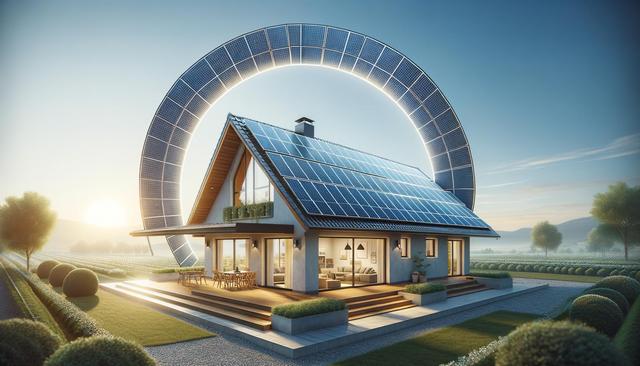A Simple Guide to Energy-Saving Solar Roofs
A Simple Guide to Energy-Saving Solar Roofs

Understanding What a Solar Roof Is
A solar roof is more than just a roofing solution; it combines protective materials with solar energy technology to generate electricity for your home. Unlike traditional solar panels that are mounted on top of existing roofs, solar roofs integrate photovoltaic cells directly into the roofing structure. This design provides a seamless aesthetic while also delivering functional energy efficiency. The concept is particularly appealing for homeowners looking to maximize energy use without compromising on design or structure.
Solar roofs are part of a broader movement toward sustainable architecture and renewable energy. As energy costs continue to rise and environmental concerns become more pressing, interest in solar roofing options has grown significantly. These roofs are designed to replace regular shingles or tiles and serve the dual purpose of roofing and energy generation. They are typically made from materials such as tempered glass or solar shingles that have built-in photovoltaic cells capable of converting sunlight into electricity.
How Solar Roofs Save Energy
Solar roofs are designed to make the most out of the sun’s energy, helping homeowners reduce their electricity bills and dependence on non-renewable energy sources. When properly installed and maintained, a solar roof can supply a significant portion of a household’s electricity needs. This energy efficiency translates into long-term savings and a reduced carbon footprint.
Here are a few ways solar roofs contribute to energy savings:
- They generate electricity directly from sunlight, reducing the need to draw power from the grid.
- They may offer better insulation under certain conditions, reducing heating and cooling demands.
- Excess energy can often be sold back to the grid, depending on local utility policies.
In many regions, homes with solar roofs qualify for tax rebates, incentives, or credits, which further reduces the net cost over time. Additionally, by decreasing peak electricity demand, solar roofs help reduce strain on public utilities and contribute to a more resilient energy infrastructure.
Installation and Design Considerations
Choosing to install a solar roof involves several important decisions, including design compatibility, structural integrity, and electrical system integration. Unlike traditional solar panels, solar roofs require a full roof replacement, making them a more suitable option for new construction or homes requiring a new roof.
Key considerations include:
- Roof orientation and angle: South-facing roofs in the northern hemisphere tend to capture the most sunlight.
- Shading: Trees, chimneys, and other buildings can block sunlight and reduce efficiency.
- Local climate and weather conditions: Performance can vary depending on sunlight availability and temperature ranges.
Homeowners should consult with qualified professionals to assess their property’s suitability and to design a system that meets their energy needs. Proper installation is crucial to ensure both the durability of the roof and the efficiency of the solar technology.
Maintenance and Longevity
One of the appealing features of solar roofs is their durability. Most solar roofing systems are designed to last for decades, often outliving traditional roofing materials. That said, regular maintenance is essential to keep the system working effectively and efficiently.
Maintenance typically involves:
- Cleaning the surface to remove dust, dirt, and debris that can block sunlight.
- Inspecting electrical connections and inverters to ensure optimal operation.
- Monitoring energy output through smart systems to identify and address any performance issues.
Many systems come with warranties covering both the roofing material and the solar components. Understanding the terms and coverage of these warranties is important for long-term planning. With proper care, solar roofs can provide reliable and clean energy for 25 years or more.
Financial and Environmental Impact
Investing in a solar roof can be a substantial upfront cost, but the long-term financial and environmental benefits often make it a worthwhile decision for many homeowners. By generating your own electricity, you can significantly reduce or even eliminate monthly utility bills. Depending on your location, you may also be eligible for federal, state, or local incentives that can offset installation costs.
From an environmental standpoint, solar roofs contribute to lowering greenhouse gas emissions by reducing the reliance on fossil fuels. This aligns with broader efforts to combat climate change and promote sustainable living. In addition, solar roofs can increase property value, as energy-efficient homes are often more attractive to buyers.
When considering a solar roof, it’s advisable to perform a cost-benefit analysis that includes:
- Initial installation and equipment costs
- Expected energy savings over time
- Available rebates or tax incentives
- Potential increase in home resale value
By weighing these factors, homeowners can make an informed decision that supports both their financial goals and environmental values.
Conclusion: Is a Solar Roof Right for You?
Solar roofs offer a compelling blend of functionality, sustainability, and modern design. For homeowners looking to reduce energy costs and environmental impact, they present a noteworthy alternative to traditional roofing and standalone solar panels. While the initial investment can be significant, the long-term benefits in energy savings and home value often outweigh the costs.
Before making a decision, it’s crucial to assess your home’s solar potential, consult with experienced professionals, and explore available financial incentives. A well-chosen solar roof system can serve as a meaningful step toward a more energy-efficient and environmentally responsible lifestyle.